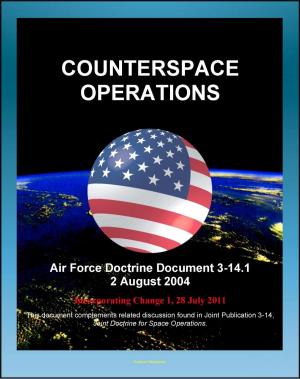Baseball Caps and Beards: The Perception of U.S. Special Forces by Conventional Forces and Its Impact on Interdependence - History from Eagle Claw and Urgent Fury to Desert Storm and War on Terrorism
Nonfiction, History, Military, Strategy, United States| Author: | Progressive Management | ISBN: | 9781370633487 |
| Publisher: | Progressive Management | Publication: | February 25, 2017 |
| Imprint: | Smashwords Edition | Language: | English |
| Author: | Progressive Management |
| ISBN: | 9781370633487 |
| Publisher: | Progressive Management |
| Publication: | February 25, 2017 |
| Imprint: | Smashwords Edition |
| Language: | English |
This excellent report has been professionally converted for accurate flowing-text e-book format reproduction. The path to Interdependence between Conventional Forces (CF) and Special Forces (SF) grew out of the success and failure in combat and peacetime operations over the last three decades. Beginning with the catastrophic collision during Operation Eagle Claw to combined operations in Iraq and Afghanistan, interdependence has been a difficult process. However, initially a difficult concept to champion, interdependence between CF and USSF allowed for a more effective use of military power against our adversaries in the Global War on Terror. Given the combination of fiscal constraints, a downsizing military, and a non-stop demand signal for military assistance in overseas contingency operations, interdependence between USSF and CF will be crucial to future mission success.
This monograph researches what the perception of United States Special Forces is by Conventional Forces and how it will affect future interdependence. In order to answer this research question this monograph will conduct a case study analysis of previous conflicts in which United States Special Forces and Conventional Forces worked together. The researcher will then conduct non-generalizable oral history interviews to understand how interactions of the past thirteen years has set the conditions for future interdependence. Synthesizing the information gathered during the research will reflect on past experience and to suggest considerations for future study.
Historical Context * Interdependence * Operation Eagle Claw * Operation Urgent Fury * Creation of Special Operations Command (SOCOM) * Operation Just Cause * Operation Desert Storm * Operation Joint Endeavor and Joint Guard * Global War on Terror * Lived Experiences during the GWOT Analysis * Experience (CONUS) * On-Post Training Created a Positive Perception Between CF and USSF Experience (OCONUS) * Professionalism and Communication Roles * Conventional Force Perception of Interdependence * Regionally Aligned Forces * Summary
The terrorist attacks on September 11, 2001 forever changed the landscape of the United States, both its citizens and its military. Embroiled in a Global War on Terror (GWOT), the United States military found itself fighting two separate large-scale wars for the last thirteen years. During the GWOT, Conventional Forces (CF) interacted closer with United States Special Forces (USSF) than at any time ever before, enhancing the capabilities of both organizations. With the cessation of hostilities and the redeployment of forces from Operation Iraqi Freedom (OIF) in 2010, and the transition of responsibilities to the Afghan government in Operation Enduring Freedom (OEF), it appeared that the Army would find itself in an interwar period.
This excellent report has been professionally converted for accurate flowing-text e-book format reproduction. The path to Interdependence between Conventional Forces (CF) and Special Forces (SF) grew out of the success and failure in combat and peacetime operations over the last three decades. Beginning with the catastrophic collision during Operation Eagle Claw to combined operations in Iraq and Afghanistan, interdependence has been a difficult process. However, initially a difficult concept to champion, interdependence between CF and USSF allowed for a more effective use of military power against our adversaries in the Global War on Terror. Given the combination of fiscal constraints, a downsizing military, and a non-stop demand signal for military assistance in overseas contingency operations, interdependence between USSF and CF will be crucial to future mission success.
This monograph researches what the perception of United States Special Forces is by Conventional Forces and how it will affect future interdependence. In order to answer this research question this monograph will conduct a case study analysis of previous conflicts in which United States Special Forces and Conventional Forces worked together. The researcher will then conduct non-generalizable oral history interviews to understand how interactions of the past thirteen years has set the conditions for future interdependence. Synthesizing the information gathered during the research will reflect on past experience and to suggest considerations for future study.
Historical Context * Interdependence * Operation Eagle Claw * Operation Urgent Fury * Creation of Special Operations Command (SOCOM) * Operation Just Cause * Operation Desert Storm * Operation Joint Endeavor and Joint Guard * Global War on Terror * Lived Experiences during the GWOT Analysis * Experience (CONUS) * On-Post Training Created a Positive Perception Between CF and USSF Experience (OCONUS) * Professionalism and Communication Roles * Conventional Force Perception of Interdependence * Regionally Aligned Forces * Summary
The terrorist attacks on September 11, 2001 forever changed the landscape of the United States, both its citizens and its military. Embroiled in a Global War on Terror (GWOT), the United States military found itself fighting two separate large-scale wars for the last thirteen years. During the GWOT, Conventional Forces (CF) interacted closer with United States Special Forces (USSF) than at any time ever before, enhancing the capabilities of both organizations. With the cessation of hostilities and the redeployment of forces from Operation Iraqi Freedom (OIF) in 2010, and the transition of responsibilities to the Afghan government in Operation Enduring Freedom (OEF), it appeared that the Army would find itself in an interwar period.















